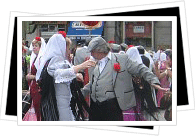Madrid People
Madrid has always been a city of immigrants and outsiders. When Phillip II moved his court here in 1561, the citizens of Spain followed despite its insignificant status and faulty infrastructure. They have continued to do so since, filling a formerly unimportant city to the brims with an eclectic mix of regional and international cultures.
Ask anyone in Madrid and they'll tell you that it's hard to find true "madrileño," as most who were born here have at least one parent from elsewhere in Spain. Nevertheless, the fact that there are few autochthonous madrileños makes it that much easier for outsiders to feel at home. In short, you don't have to be from Madrid to be a madrileño.
 Typical Madrid traditions - "castizo" garb, music and dance - do exist, though they emerge fairly infrequently. Your best bet is to attend the Madrid festivals of San Isidro (May) or La Paloma (August) if you want to get a taste of authentic Madridian customs.
Typical Madrid traditions - "castizo" garb, music and dance - do exist, though they emerge fairly infrequently. Your best bet is to attend the Madrid festivals of San Isidro (May) or La Paloma (August) if you want to get a taste of authentic Madridian customs.
The central characteristic that unites Madrid people is easy to identify: they love to socialize. You will find people on the streets at all hours of the night, every night of the week. And, on the whole, Madrid's inhabitants are quite friendly and ready to welcome you to the fiesta with them.
About 17% of Madrid's censused population (approx. 3 million total) are immigrants. The countries most highly represented are (in descending order): Ecuador, Colombia, Perú, Romania, Bulgaria, Bolivia and Argentina.
Formerly part of the region of Castilla (Madrid is now its own region), the people of Madrid historically spoke and continue to speak "castellano," also known simply as Spanish. Therefore, unlike many other parts of Spain, there is no regional language here. This makes it a great place to study Spanish - apart from the fact the good English speakers remain surprisingly few and far between.
